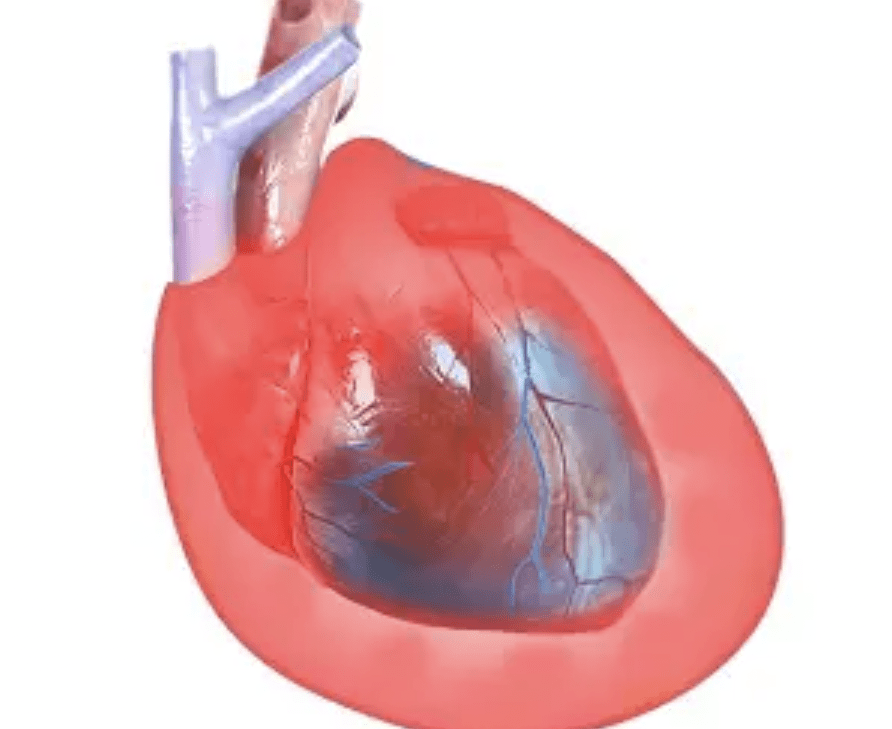Author : Dr. Prajwal ( MD Internal Medicine )
Acute Pericarditis is an inflammation of the Pericardium Which is Characterized by Pericarditic chest pain , Pericardial friction rub , and serial ECG changes which may include new wide spread ST elevation or PR depression ; new/worsening Pericardial effusion. Early Detection and intervention could lessen the chance of Pericarditis related long term sequences .
Signs and Symptoms of Pericarditis :
1:Chest Pain is the Cardinal symptom of pericarditis , usually precordial or retrosternal with referral to trapezius ridge , neck , left shoulder or arm.
2: Associated signs and symptoms may include low grade intermittent fever, Tachypnea / Dyspnea, Cough and Dysphagia.
3: In Tuberculous Pericarditis fever ,night sweats and weight loss are commonly found.
Also Note : The Particular symptoms vary depending on Specific Type of Pericarditis. Pericarditis is divided into following types :
1: Acute Pericarditis develops rapidly and lasts no more than 3 weeks . It could be challenging to distinguish between Pain of Heart attack and Acute Pericarditis
2: After Acute Pericarditis , Recurrent Pericarditis develops 4 – 6 weeks later with no symptoms in between .
3: Persistent Pericarditis lasts for four to six weeks , but not longer than three months. Signs never go away
4: Chronic constrictive Pericarditis takes longer than 3 months to develop and Progress
Etiology of Pericarditis :
The Underlying Cause of pericarditis maybe infectious or noninfectious. Pericarditis is predominantly referred as Idiopathic in developed nations.
Other Specific Causes of Pericarditis may include :
1: Infectious Conditions , Such as Viral, bacterial and Tuberculous infections .
2: Inflammatory disorders which may include SLE, RA , Rheumatic fever and Scleroderma
3: Cardiovascular disorders , Such as Acute MI, Aortic dissection and Dressler Syndrome
4: Metabolic disorders such as renal failure and Hypothyroidism
5: Miscellaneous Causes, such as iatrogenic ,drugs irradiation ,neoplasms , Cardiovascular procedures, Sarcoidosis and Trauma.
Diagnosis of Pericarditis :
Initial evaluations may include clinical history and Physical examinations, followed by ECG, echocardiography, chest radiographs and lab studies .
1: ECGs can be diagnostic in acute pericarditis and typically shows diffuse ST elevation. The ratio of amplitude of ST segments to the amplitude of T waves in lead 1,V4,V5 and V6 on ECG can be used to differentiate acute pericarditis from early repolarization and early repolarization of Left Ventricular hypertrophy.
2: Echocardiography is indicated if PERICARDIAL EFFUSION is suspected on clinical or Radiographic grounds, illness lasts longer than one week , purulent pericarditis , or myocarditis is suspected.
3: A chest radiograph is helpful to exclude Pulmonary conditions that maybe responsible or associated with cause of pericarditis such as cancer, SLE , Sarcoidosis , and Infections. NOTE THAT It is not helpful for evaluating the presence of Pericardial fluid as patients with small effusions ( less than 100 milliliters) may present with normal Cardiac silhouette; It is only helpful for diagnosing fluid in patients with effusions larger than 250 ml.
Laboratory Tests :
1: Complete blood count ( CBC) with differential and Coagulation studies : Significant Leukocytosis maybe present with an either inflammatory or infective cause of Pericarditis . Also determine , Prothrombin time / activated Partial thromboplastin time if abnormal correct in order to lessen the chance of developing tamponade .
2: Serum Electrolytes, Blood urea Nitrogen and Creatinine levels : Determine the serum electrolytes concentrations such as Sodium, Potassium, magnesium, chloride ,calcium and phosphate levels because of the increased risks of arrhythmias in patients with Pericarditis. In addition during dialysis frequent monitoring of electrolytes is helpful to detect and treat hypokalemia and hypophosphatemia , especially in patients with DIALYSIS ASSOCIATED PERICARDITIS .
BUN and Creatinine are measured to evaluate for Uremia . These levels are often elevated with Azotemia.
3: Erythrocyte sedimentation rate and C – reactive Protein levels : ESR and CRP levels are elevated in most of the cases of Acute pericarditis . Thus an elevated CRP levels may confirm the diagnosis of acute pericarditis.
NOTE : A Normal value does not exclude the diagnosis of acute pericarditis. In some Patients ,the hs – CRP increases later, supporting the use of serial testing in patients with an initial negative results .
4: Cardiac biomarker measurements, Lactate dehydrogenase , and Serum glutamic – oxaloacetic transaminase levels : Cardiac biomarkers such as Creatinine kinase and isoenzyme levels , as well as LDH and AST for associated myocarditis or Myocardial infarction. Troponin I maybe elevated in viral or Idiopathic acute pericarditis .
Further laboratory studies maybe clinically indicated as follows :
1: Blood and Viral Cultures
2: Tuberculosis skin testing or Tuberculin sputum testing for acid – fast bacilli can be used if illness exceeds one week duration.
3: Rheumatoid Factor, Antinuclear antibody , and Anti DNA values, particularly if illness is prolonged.
4: ESC 2004 guidelines on diagnosis and management of pericardial disease recommends pericardial fluid or pericardial or epicardial biopsy analyses to confirm diagnosis of malignant pericardial disease.
5: HIV testing
Management :
Treatment for specific causes of pericarditis is directed according to underlying cause. For Patients with Idiopathic or Viral pericarditis , Therapy is directed at symptom relief.
Pharmacological Treatment :
Aspirin and NSAIDs ( Nonsteroidal anti – inflammatory drugs ) are the mainstay of the therapy. NSAID agents have similar efficacy , with relief of chest pain in about 85-90% of patients within days of treatment. Recommended to use full dose of NSAID and treatment should last for 7-14 days.
Even we can consider Colchicine alone or in combination with aspirin or an NSAID , can be considered as first line therapy as an adjunct for patients with acute pericarditis, Particularly to prevent recurrences .
NOTE : Don’t use Corticosteroids for initial treatments of pericarditis unless it is indicated for underlying disease, Patients condition has no response for NSAIDs or Colchicine, or in case both agents are contraindicated .
Surgical Treatment :
Surgical Procedures for Pericarditis may include Pericardiocentesis , Pericardiectomy, Pericardiotomy and Pericardial window placement .
Pericardiectomy is the most effective surgical procedure to manage large effusions as it has the lowest associated risk of recurrent effusions. This Procedure is used for Effusion Pericarditis, Constrictive Pericarditis, Recurrent pericarditis, steroid dependence or any intolerance to medical management.
Patients with Effusions larger than 250ml , effusions in which size increases despite intensive dialysis for 10 -14 days or effusions with evidence of tamponade are candidates for Pericardiocentesis.
Pericardial window placement is used for effusive pericarditis therapy. In Critically ill patients , a balloon catheter maybe used to create the pericardial window ,in which only 9cm2 or less of pericardium is resected.
We may consider the Subxiphoid pericardiotomy for large effusion that do not resolve. This procedure maybe performed under local anesthesia and has lower risk of complications than pericardiectomy.






Leave feedback about this